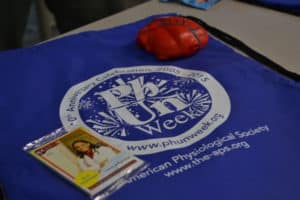Nov. 19, 2018 | Nearly three dozen students in ninth through 12th grades from Little Rock Central High School visited the UAMS campus recently to participate in PhUn Day, organized by the UAMS Center for Diversity Affairs and the Department of Physiology and Biophysics in the UAMS College of Medicine as part of the American Physiological Society’s national Physiology Understanding (PhUn) Week program.
“PhUn Week is a nationwide outreach program that started in 2005 building connections between scientists and their local schools,” said Parimal Chowdhury, Ph.D., a professor in the UAMS College of Medicine’s Department of Physiology and Biophysics, who added that UAMS has been participating since 2008. “It fosters grassroots partnerships between biomedical researchers and K-12 teachers.”
Chowdhury is a full-time member of the American Physiological Society and has been organizing this event for many years in Little Rock. In 2015, the American Physiological society awarded UAMS with a plaque for its five-year continuous participation in this event.
After being welcomed and having the importance of PhUn Week explained by Chowdhury, students spent the morning learning about real-world applications of concepts they’ve studied in science classes, hearing short lectures on transgenic research, genome sequencing, radiology and fitness. Presenters included: Patricia Wright, Ph.D., UAMS professor of physiology and biophysics; Steward Macleod, Ph.D., director of the Center for Translational Pediatric Research Genomics Lab at Arkansas Children’s Research Institute; Rupak Pathak, Ph.D., an associate professor of pharmaceutical science; and Adam Carter, M.Sc., manager of the UAMS Fitness Center.
“The contacts made by student participants, teachers and science professionals at UAMS help students with their future decision-making processes for their career,” said Chowdhury. “Many of these participants return to UAMS for continuation of their education and medical degrees.”
After the morning lectures, the students were split into groups and given tours of the Fitness Center, the Simulation Center and a handful of UAMS research labs. During these tours, which were led by UAMS staff and graduate and medical students, the visitors were able to see firsthand some of the research being undertaken at UAMS and were able to see how health care professionals learn and practice skills like intubation using lifelike manikins.

“From the perspective of an educator, I find this hands-on process vital in encouraging these students to remain engaged in studying science or science-related disciplines available here at UAMS,” Chowdhury explained. “Both UAMS and student participants are beneficiaries of this interaction, as far as my experience is concerned.”


